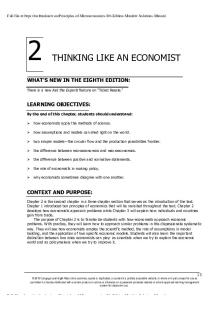ECON-HW5 - Homework assignment and great study guide for principles of microeconomics. PDF

| Title | ECON-HW5 - Homework assignment and great study guide for principles of microeconomics. |
|---|---|
| Author | Veronica Thordardottir |
| Course | Principles Of Microeconomics |
| Institution | East Carolina University |
| Pages | 6 |
| File Size | 104 KB |
| File Type | |
| Total Downloads | 24 |
| Total Views | 131 |
Summary
Homework assignment and great study guide for principles of microeconomics. ...
Description
ECON 2113 HW 5 Due 10/26 Multiple Choice Identify the choice that best completes the statement or answers the question. Show appropriate work where necessary. Ch. 9—International Trade B
1. A tax on an imported good is called a a. quota. b. tariff. c. supply tax. d. trade tax.
D
2. The price of a good that prevails in a world market is called the a. absolute price. b. relative price. c. comparative price. d. world price.
D
3. The price of cotton that prevails in international markets is called the a. export price of cotton. b. import price of cotton. c. comparative-advantage price of cotton. d. world price of cotton.
B
4. If a country allows trade and, for a certain good, the domestic price without trade is higher than the world price, a. the country will be an exporter of the good. b. the country will be an importer of the good. c. the country will be neither an exporter nor an importer of the good. d. Additional information is needed about demand to determine whether the country will be an exporter of the good, an importer of the good, or neither.
A
5. If a country allows trade and, for a certain good, the domestic price without trade is lower than the world price, a. the country will be an exporter of the good. b. the country will be an importer of the good. c. the country will be neither an exporter nor an importer of the good. d. Additional information is needed about demand to determine whether the country will be an exporter of the good, an importer of the good, or neither.
C
6. Trade among nations is ultimately based on a. absolute advantage. b. strategic advantage. c. comparative advantage. d. technical advantage.
Figure 9-1
B
7. Refer to Figure 9-1. Without trade, consumer surplus is a. $210. c. $455. b. $245. d. $490.
A
8. Refer to Figure 9-1. Without trade, producer surplus is a. $210. c. $455. b. $245. d. $490.
D
9. Refer to Figure 9-1. With free trade, this country will a. import 40 baskets. b. import 70 baskets. c. export 35 baskets. d. export 65 baskets.
A
10. Refer to Figure 9-1. If this country chooses to trade, the price of baskets in this country will be a. $10 and 40 baskets will be sold domestically. b. $10 and 105 baskets will be domestically. c. $7 and 70 baskets will be sold domestically. d. $7 and 40 baskets will be sold domestically.
B
11. Refer to Figure 9-1. With free trade, consumer surplus is a. $45. b. $80. c. $210. d. $245.
D
12. Refer to Figure 9-1. With free trade, producer surplus is a. $80.00. b. $210.00. c. $245.50. d. $472.50.
B
13. Refer to Figure 9-1. As a result of trade, total surplus increases by
a. b. c. d.
$80. $97.50. $162.50. $495.50.
D
14. Refer to Figure 9-1. This country a. has a comparative advantage in baskets. b. should export baskets. c. is a price taker in the world economy. d. All of the above are correct.
A
15. Refer to Figure 9-1. The world price for baskets represents a. the demand for baskets from the rest of the world. b. the supply of baskets from the rest of the world. c. the level of inefficiency in the domestic market caused by trade. d. the gap between domestic quantity demanded and domestic quantity supplied and the resulting shortage.
B
16. Refer to Figure 9-1. At the world price and with free trade, a. the domestic quantity of baskets demanded is greater than the domestic quantity of baskets supplied. b. the basket market is in equilibrium. c. the domestic demand for baskets is perfectly inelastic. d. both domestic producers of baskets and domestic consumers of baskets are better off than they were without free trade....
Similar Free PDFs

Principles of microeconomics HW1
- 10 Pages

Microeconomics Final Study Guide
- 23 Pages

5 Principles of Great Management
- 3 Pages
Popular Institutions
- Tinajero National High School - Annex
- Politeknik Caltex Riau
- Yokohama City University
- SGT University
- University of Al-Qadisiyah
- Divine Word College of Vigan
- Techniek College Rotterdam
- Universidade de Santiago
- Universiti Teknologi MARA Cawangan Johor Kampus Pasir Gudang
- Poltekkes Kemenkes Yogyakarta
- Baguio City National High School
- Colegio san marcos
- preparatoria uno
- Centro de Bachillerato Tecnológico Industrial y de Servicios No. 107
- Dalian Maritime University
- Quang Trung Secondary School
- Colegio Tecnológico en Informática
- Corporación Regional de Educación Superior
- Grupo CEDVA
- Dar Al Uloom University
- Centro de Estudios Preuniversitarios de la Universidad Nacional de Ingeniería
- 上智大学
- Aakash International School, Nuna Majara
- San Felipe Neri Catholic School
- Kang Chiao International School - New Taipei City
- Misamis Occidental National High School
- Institución Educativa Escuela Normal Juan Ladrilleros
- Kolehiyo ng Pantukan
- Batanes State College
- Instituto Continental
- Sekolah Menengah Kejuruan Kesehatan Kaltara (Tarakan)
- Colegio de La Inmaculada Concepcion - Cebu












